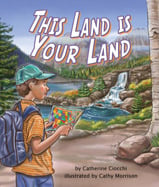Alignment to Standards for TN

| Grade | Number | Standard |
|---|---|---|
| 1 | SC-1.9.1. | Identify the earthês major geological features. |
| 1 | SC-1.9.1.a | Distinguish between land and water environments. |
| 1 | SS-1.3.01. | Understand how to use maps, globes, and other geographic representations, tools, and technologies to acquire, process and report information from a spatial perspective. |
| 1 | SS-1.3.01.a | maps and globes are representations or models of specific places. |
| 1 | SS-1.3.01.d | Interpret symbols that represent various forms of geographic data and use these symbols to identify locations and directions. |
| 1 | SS-1.3.02. | Recognize how to identify and locate major physical and political features on maps and globes. |
| 1 | SS-1.3.02.a | Define what cardinal directions are. |
| 1 | SS-1.3.02.b | Locate places using cardinal directions on maps and globes. |
| 1 | SS-1.3.02.c | Locate cities, states, countries, and continents on maps and globes and major bodies of water on maps and globes. |
| 1 | SS-1.3.03.b | Define natural resources and explain how people are dependent on them. |
| 1 | SS-1.3.03.c | Compare/contrast natural and artificial features of the earth. |
| 2 | SC-2.9.1. | Identify the earthês major geological features. |
| 2 | SC-2.9.1.a | Recognize the earthês major geological features (e.g., continents, oceans, lakes). |
| 2 | SS-2.3.01. | Understand how to use maps, globes, and other geographic representations, tools, and technologies to acquire, process and report information from a spatial perspective. |
| 2 | SS-2.3.01.d | Recognize that a map contains elements such as title, scale, symbols, legends, grids, cardinal and intermediate direction. |
| 2 | SS-2.3.03. | locate major physical and political features on globes and maps. |
| 2 | SS-2.3.03.a | Show how landmasses and bodies of water are represented on maps and globes. |
| 3 | SC-3.9.1. | Identify the earthês major geological features. |
| 3 | SC-3.9.1.a | Compare and contrast a variety of different landforms and bodies of water. |
| 3 | SS-3.3.01. | Understand how to use maps, globes, and other geographic representations, tools, and technologies to acquire, process and report information from a spatial perspective. |
| 3 | SS-3.3.02.b | List the basic components of earth's physical systems (e.g., landforms, water, climate and weather, erosion and deposition). |
| 3 | SS-3.3.03. | Demonstrate how to identify and locate major physical and political features on globes and maps. |
| 4 | SC-4.9.1. | Recognize that the earthês geological features change. |
| 4 | SC-4.9.1.a | Observe and describe how wind and water change the earthês geological features. |
| 4 | SS-4.3.01.b | Locate places on a map using cardinal and intermediate directions, latitude and longitude, and time zones. |
| 5 | SC-5.8.2 | Recognize that landforms and bodies of water affect weather and climate. |
| 5 | SC-5.9.1. | Recognize that the earthês geological features change. |
| 5 | SC-5.9.1.a | Explain how certain forces cause changes in the earthês geological features (i.e., wind, water, plate tectonics). |
| K | SS-K.3.01. | Understand how to use maps, globes, and other geographic representations, tools, and technologies to acquire, process and report information from a spatial perspective. |
| K | SS-K.3.01.a | Explain what a globe and map represent. |
| K | SS-K.3.03. | Demonstrate how to identify and locate major physical and political features on globes and maps. |
| K | SS-K.3.03.a | Identify the concept of physical features as in mountains, plains, hills, oceans, and islands. |